What Animal Classification Is A Bird In
| ? | ||||||||
|---|---|---|---|---|---|---|---|---|
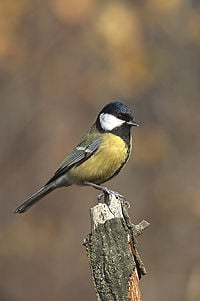 Groovy Tit, Parus major | ||||||||
| Scientific classification | ||||||||
| ||||||||
| Orders | ||||||||
| |
Birds (form Aves) are bipedal, warm-blooded, oviparous (egg-laying) vertebrates characterized primarily by feathers, forelimbs modified as wings, and a bony neb without teeth. Common characteristics of birds include the laying of difficult-shelled eggs, high metabolic rate, and a light simply strong skeleton, generally with hollow basic.
The only animals covered with feathers, nearly birds are characterized past flying. Many birds migrate long distances to use optimum habitats (eastward.m., Arctic tern), while others spend almost all their time at sea (e.k., the wandering albatross). Some, such as frigatebirds, stay aloft for days at a fourth dimension, even sleeping on the wing. The fastest living animate being is a bird, the peregrine falcon (Falco peregrinus), which has been observed to attain a flying speed of at least 124 mph (200 km/h) and perhaps 350 km/h (217 mph) during a dive. On the other hand, the ratites are flightless, and several other species, particularly on islands, have also lost this ability. Flightless birds include the penguin, ostrich, kiwi, and the extinct dullard.
Birds range in size from the tiny hummingbirds to the huge ostrich and emu. Depending on taxonomic viewpoint, there are almost 8,800 to 10,200 living bird species in the world, making them the most diverse class of terrestrial vertebrates.
The path of humans and birds have intersected in many means throughout human culture, whether directly through hunting and domestication, or as powerful symbols in literature, arts, and religion. The dove has been used as a symbol of peace and love, as well as the Holy Spirit in Christianity; cranes have symbolized long life, and owls wisdom. The bulk of birds are monogamous and many species mate for life, reflecting the higher aspirations of the human being spirit and religion.
Birds are a very differentiated form, with some feeding on nectar, plants, seeds, insects, rodents, fish, carrion, or other birds. Some birds even feed on parasites on black rhinoceroses, or within the mouths of crocodiles. Most birds are diurnal, or active during the day. Some birds, such as the owls and nightjars, are nocturnal or crepuscular (active during twilight hours). Many birds seasonally migrate long distances, improving opportunities for nutrient, better climate, and breeding.
Contents
- ane Bird classification
- 1.i Bird orders
- 1.2 Species and habitats
- 2 Anatomy and physiology
- two.one Feathers
- 2.ii Skeleton
- two.3 Digestive system
- two.iv Respiration
- ii.5 Circulatory, nervous and metabolic systems
- 2.half-dozen Reproduction
- 3 Mating systems and parental care
- 4 Birds and humans
- iv.one Birds as nutrient and products
- 4.2 Birds as pets and to perform tasks
- four.3 Birds in art, literature, and religion
- 4.iv Human-caused declines in birds
- 5 Evolution
- 6 References
- 7 Credits
Birds are among the most extensively studied of all fauna groups. Hundreds of academic journals and thousands of scientists are devoted to bird enquiry, while amateur enthusiasts (chosen birdwatchers or birders) probably number in the millions.
Bird classification
Birds form a grade, whose scientific proper noun is Aves. Mod birds are classified in the bracket Neornithes, which is farther separated into ii superorders, the Paleognathae (mostly flightless birds), and the wildly diverse Neognathae, containing all other birds. At that place is also an extinct subclass, Archaeornithes.
The paleognaths include the tinamous (plant simply in Primal and South America) and the ratites. The ratites are large flightless birds, and include ostriches, cassowaries, kiwis, and emus. Some scientists suspect that the ratites represent an artificial grouping of birds which have independently lost the ability to wing, while others contend that the ratites never had the power to fly and are more direct related to the dinosaurs than other modern birds.
The classification of birds is a contentious effect. Sibley and Ahlquist's Phylogeny and Classification of Birds (1990) is an often cited work on the classification of birds, just is besides frequently debated and constantly revised. Show has been accumulated that the modern bird orders establish authentic taxa. Still, scientists are not in agreement as to the relationships between the orders; testify from modern bird beefcake, fossils and DNA take all been brought to bear on the trouble but no stiff consensus has emerged. Some postulated the Galloanseri (see nautical chart) every bit the basal divergence from the remaining Neognathes. The Galloanseri incorporate the Anseriformes (ducks, geese and swans), and the Galliformes (the pheasants, grouse, and their allies). While in that location is general consensus that the orders Anseriformes and Galliformes represent sister-groups, there remain opposing points of view.
Bird orders
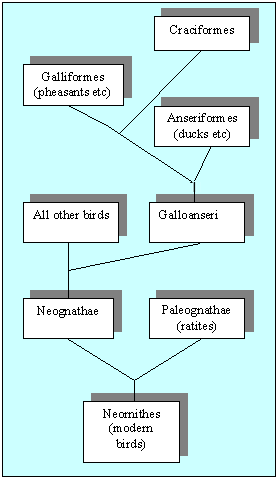
Relationships between bird orders
This is a list of the taxonomic orders in the class Aves. The list of birds gives a more than detailed summary, including families.
- Struthioniformes, Ostrich, emus, kiwis, and allies
- Tinamiformes, tinamous
- Anseriformes, waterfowl
- Galliformes, fowl
- Sphenisciformes, penguins
- Gaviiformes, loons
- Podicipediformes, grebes
- Procellariiformes, albatrosses, petrels, and allies
- Pelecaniformes, pelicans and allies
- Ciconiiformes, storks and allies
- Phoenicopteriformes, flamingos
- Accipitriformes, eagles, hawks and allies
- Falconiformes, falcons
- Turniciformes, push-quail
- Gruiformes, cranes and allies
- Charadriiformes, plovers and allies
- Pteroclidiformes, sandgrouse
- Columbiformes, doves and pigeons
- Psittaciformes, parrots and allies
- Cuculiformes, cuckoos
- Strigiformes, owls
- Caprimulgiformes, nightjars and allies
- Apodiformes, swifts
- Trochiliformes, hummingbirds
- Coraciiformes, kingfishers
- Piciformes, woodpeckers and allies
- Trogoniformes, trogons
- Coliiformes, mousebirds
- Passeriformes, passerines
Annotation: This is the traditional classification (the so-called Clements order). A more recent, substantially different classification based on molecular data has been adult (the then-chosen Sibley guild) and is gaining acceptance.
Species and habitats
The estimated number of living bird species is often put around ten thousand, but ranges from 8,800–10,200. This compares to about 4,800 species of mammals and 7,150 species of reptiles.
Birds have adjusted to nearly every part of the globe and a broad variety of habitats: forests, grasslands, cities, mountains, deserts, wetlands, and oceans. Even the snowy owl (Bubo scandiacus) is adapted to live northward of the Chill Circle, where the temperature can be beneath -46°C during the winter, and penguins thrive in the Antarctica. The albatrosses spend much of their fourth dimension soaring over the open ocean, and the emperor penguin (Aptenodytes forsterican) plunges to depths of more than than 250 meters (850 feet) searching for nutrient.
However, birds have generally been adapted to terrestrial land—just ii percent of all birds are aquatic. Virtually of these, about 150 species, are duck like birds, every bit well every bit a small number of grebes (20), loons (4), penguins (fifteen), and auks (21) (Mayr 2001). Additionally, merely a few birds are foliage-eaters, with a notable one beingness the hoatzin (Ophisthocomus hoazin).
Anatomy and physiology
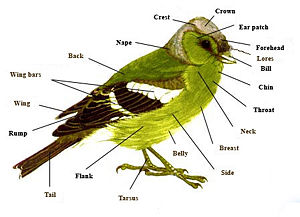
Beefcake of a typical bird
Feathers
A distinguishing characteristic of birds is feathers. Other animals accept wings and can wing, such as bats, but only birds are covered with feathers.
Feathers are among the most complex structural organs found in vertebrates. These integumentary appendages are formed by controlled proliferation of cells in the epidermis (outer skin layer) from a poly peptide chosen keratin. These gristly structural proteins form the hard, but non-mineralized structures found in bird feathers, beaks, and claws, likewise as reptilian claws, shells, and scales, and mammalian hair (including wool), nails, claws, horns, and hooves of mammals. The β-keratins used by birds and reptiles are even tougher than the α-keratins of mammals.
Feathers insulate birds from water and cold temperatures. Individual feathers in the wings and tail play important roles in controlling flying. Colour patterns serve as camouflage against predators for birds in their habitats, and by predators looking for a meal. Striking differences in plumage patterns and colors are office of the sexual dimorphism of many bird species and are especially important in option of mating pairs. The blue and greenish colors in most parrots are attributed to a texture effect in microscopic portions of the plumage itself, rather than pigment.
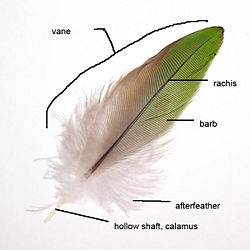
parts of a profile feather
Skeleton
Birds likewise accept skeletons possessing unique characteristics.
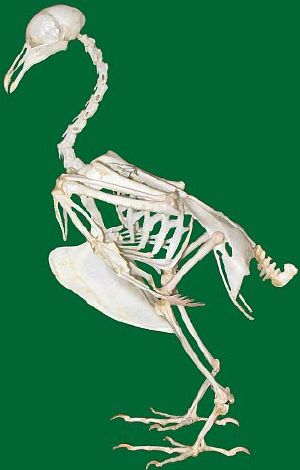
The avian (bird) skeleton is highly adapted to these animals' capacity for flight. It is extremely lightweight, simply strong enough to withstand the stresses that a bird experiences when taking off, flight and landing. I of the adaptations that make this possible is the fusing of basic that are carve up in mammals into single ossifications. Considering of this, birds ordinarily take a smaller number of bones than mammals or reptiles, and the frame has more forcefulness.
Birds have many bones that are hollow, with criss-crossing struts or trusses (cross walls) for structural strength. (Some flightless birds like penguins have but solid basic, however). The number of hollow basic varies from species to species, though large gliding and soaring birds tend to take the most.
Birds too have more cervical (neck) vertebrae than many other animals; most accept a highly flexible neck that consists of 13-25 vertebrae. Although the neck is flexible, most of the skeleton is rather stiff. Birds are the only vertebrate animals to accept a fused collarbone (the furcula or wishbone) or a keeled breastbone (or sternum). The heaviest and strongest bone is the coracoid.
Although feathers are light, a bird'southward plumage weighs two or 3 times more its skeleton, since many bones are hollow and comprise air sacks. The lack of teeth also lightens the frame.
The pectoral (chest) muscles of birds are the largest, and may account for 20% of a bird's weight.
Digestive system
A bird's digestive system extends from the mouth, through the pharynx, into the esophagus, into the breadbasket, through the small intestine and the large intestine, and out the cloacal opening. Some birds accept a crop, which is a storage pouch that is part of the esophagus and tin allow birds to feed and store food until afterward digestion. About birds take a stomach fabricated of two parts, the offset part, or proventriculus, which secretes digestive fluids, and the second, the gizzard.
Lacking teeth, birds apply their digestive organization to grind and pulverize food. The ventriculus or gizzard is equanimous of 4 muscular bands that human action to rotate and crush food by shifting the food from one area to the next inside the gizzard. Depending on the species, the gizzard may comprise small-scale pieces of grit or stone that the bird has swallowed to aid in the grinding process of digestion. For birds in captivity, only certain species of birds require dust in their nutrition for digestion. The employ of gizzard stones appears to be a similarity betwixt birds and dinosaurs, based on trace fossils of gizzard stones called gastroliths.
Respiration
The high metabolism of birds necessitates an effective system for acquiring a great deal of oxygen.
Birds ventilate their lungs by means of crosscurrent menstruum: the air flows at a 90° angle to the menses of blood in the lungs' capillaries. In addition to the lungs themselves, birds have posterior and inductive air sacs (typically nine), which command airflow through the lungs, merely do not play a direct office in gas exchange. There are iii distinct sets of organs involved in respiration:
- the anterior air sacs (interclavicular, cervicals, and anterior thoracics),
- the lungs, and
- the posterior air sacs (posterior thoracics and abdominals).
It takes bird two full breaths to completely cycle the air from each inhalation through its lungs and out again. Air flows through the air sacs and lungs as follows:
- Beginning inhalation: air flows through the trachea and bronchi into the posterior air sacs.
- First exhalation: air flows from the posterior air sacs to the lungs.
- Second inhalation: air flows from the lungs to the inductive air sacs.
- 2nd exhalation: air flows from the anterior sacs dorsum through the trachea and out of the body.
Since during inhalation and exhalation fresh air flows through the lungs in only one direction, there is no mixing of oxygen rich air and carbon dioxide rich air within the lungs as in mammals. Thus the partial pressure of oxygen in a bird's lungs is the same as the surroundings, and so birds have more efficient gas-exchange of both oxygen and carbon dioxide than do mammals.
Avian lungs do not have alveoli, as mammalian lungs do, just instead contain millions of tiny passages known as parabronchi, connected at either ends past the dorsobronchi and ventrobronchi. Air flows through the honeycombed walls of the parabronchi and into air capillaries, where oxygen and carbon dioxide are traded with cross-flowing claret capillaries by improvidence.
Circulatory, nervous and metabolic systems
Birds have four-chambered hearts, and a circulatory system with blood vessels. Birds' loftier metabolism requires rapid circulation because of the quick build up of waste products, and demand for oxygen.
In general, birds more often than not have exceptional vision, well-developed hearing, and a poor sense of smell. Equally a group, their vision is the best of all animals. Large optics, oftentimes heavier than their brain, offer strong visual acuity and color perception. Yet, Kiwi, flightless, nocturnal birds endemic (native) to New Zealand, are nearly bullheaded. They rely on a highly developed sense of smell, with nostrils at the end of their long nib. Most birds practice not accept a good sense of odour. Hearing is generally well developed. For example, even without light, or whatever visual cues, barn owls can runway their casualty by sound.
Birds are both endothermic (create their own heat) and homeothermic (maintain a abiding internal temperature). They also generally maintain a higher body temperature than mammals, with a temperature generally between forty and 44°C. About eighty per centum of bird species maintain higher temperature than all but x% of mammal species.
Birds also mostly have a faster heart rate and a greater need for oxygen than mammals, and have a higher metabolic charge per unit. Smaller birds generally have a college metabolism than larger birds, and have relatively higher energy needs. A hummingbird must feed almost constantly during the day, whereas an emperor penguin goes more than two months without feeding while incubating the couple'due south egg.
Reproduction
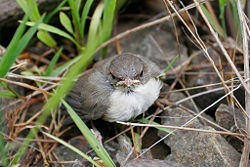
Babe bird unable to fly withal
Although most male birds accept no external sex organs, the male does have two testes which get hundreds of times larger during the convenance season to produce sperm. The female's ovaries likewise become larger, although only the left ovary actually functions.
In the males of species without a phallus (run across beneath), sperm is stored inside the proctodeum compartment inside the cloaca prior to copulation. During copulation, the female moves her tail to the side and the male person either mounts the female person from backside or moves very close to her. He moves the opening of his cloaca, or vent, close to hers, and then that the sperm can enter the female'due south cloaca, in what is referred to as a cloacal kiss. This can happen very fast, sometimes in less than one second.
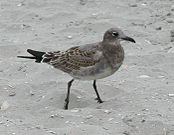
A juvenile Laughing Gull.
The sperm is stored in the female person'southward cloaca for anywhere from a week to a year, depending on the species of bird. Then, 1 by 1, eggs will descend from the female'southward ovaries and get fertilized by the male person'southward sperm, earlier being subsequently laid by the female. The eggs will so keep their development in the nest.
Many waterfowl and some other birds, such equally the ostrich and turkey, practise possess a phallus. Except during copulation, it is hidden within the proctodeum compartment within the cloaca, only within the vent. The avian phallus is purely a copulatory organ and is not used for expelling urine.
After the eggs hatch, parent birds provide varying degrees of intendance in terms of food and protection. Precocial birds—those that are relatively mature at birth—tin care for themselves independently within minutes of hatching. Altricial hatchlings—those born helpless—are blind and naked, and require extended parental care. The chicks of many ground-nesting birds, such every bit partridges, chickens, and waders, are frequently able to run virtually immediately after hatching; such birds are referred to as nidifugous. The immature of hole-nesters, on the other manus, are oftentimes totally incapable of unassisted survival. The procedure whereby a chick acquires feathers until it can fly is called "fledging."
Mating systems and parental care
(Clockwise from top left) The jabiru (Jabiru mycteria), the green-and-red macaw, or green-winged macaw (Ara chloroptera), the bald eagle (Haliaeetus leucocephalus), and the boundness (family Diomedeidae) are examples of birds that mate for life.
The three mating systems that predominate among birds are polyandry, polygyny, and monogamy. Monogamy (having ane partner for reproduction and raising the immature) is seen in approximately 91% of all bird species. Polygyny (1 male with more than one female) constitutes 2% of all birds, and polyandry (ane female with more than than one male) is seen in less than one%.
Monogamous species of males and females pair for the breeding season. In some cases, the individuals may pair for life. For example, the boundness, baldheaded eagle, and Canadian goose, as well equally species of macaws, owls, and crows, mate for life. When the mate dies, there is oftentimes a re-mating of the surviving bird. There are instances of one bird showing signs of distress upon the expiry of a mate, although when the mate is removed from the sight of the survivor, this behavior subsides.
1 caption for the high rate of monogamy amid birds is the fact that male birds are merely as proficient at parental care as females. In most groups of animals, male parental care is rare, but in birds it is quite common; in fact, it is more extensive in birds than in any other vertebrate course. In birds, male person care tin can exist seen as important or essential to female person fitness. "In 1 form of monogamy, such every bit with obligate monogamy, a female cannot rear a litter without the aid of a male person" (Gowaty 1983).
The parental beliefs about closely associated with monogamy is male incubation. Interestingly, male incubation is the most circumscribed male parental beliefs. It takes fourth dimension and also may require physiological changes that interfere with continued mating. For example, in the instance of the emperor penguin, after the female penguin lays its egg, she returns to the sea to feed for ii months to replenish her nutritional reserves. During this fourth dimension, the male person incubates the egg in its brood pouch for most two months consecutively without food. If the chick hatches before the mother'south return, the father feeds it a substance produced by a gland in his esophagus.
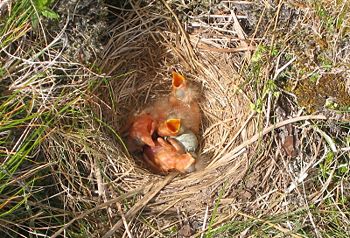
These redwing hatchlings are completely dependent on parental care.
Monogamy does not necessarily translate to fidelity amid the pairs, as examples to the contrary are known. It is certainly problematic to compare mating habits of species in cosmos with human habits, given that people are endowed with a spiritual as well as physical nature. (See human and man trunk.) However, the dominance of monogamy in birds, and the extensive phenomena of pairing for life as a universal standard within sure bird species, provides a counterbalance to the current social Darwinistic views of some that monogamy, pairing for life, and fidelity in humans is an unnatural land. (Come across reproduction for an elaboration of this perspective.)
Birds and humans
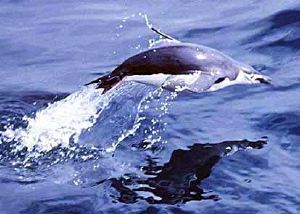
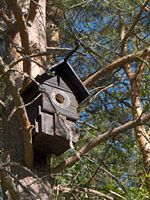
Birdbox is an artificial platform for birds to make a nest
Throughout the ages, birds accept been integral to human being culture, whether as nutrient, pets, bird products, or inspiration for paintings, literature, and religion. Unfortunately, hunting, destruction of habitat, and pollution take also caused many birds to exist placed on lists as endangered or threatened species. In that location are also an estimated (plus about 120–130 that have become extinct in the bridge of man history.
Birds every bit food and products
Birds are an important nutrient source for humans. The near commonly eaten species is the domestic chicken and its eggs, although geese, pheasants, turkeys, and ducks are also widely eaten. Other birds that have been utilized for nutrient include emus, ostriches, pigeons, grouse, quails, doves, woodcocks, songbirds, and others, including small passerines, such as finches. At in one case swans and flamingos were delicacies of the rich and powerful, although these are generally protected now.
Birds have served equally a food source since prehistoric times. Eventually, people were able to domesticate birds, including chickens, ducks, and turkeys.
Birds have also provided products for use in human societies, such as feathers and skins. Feathers have been used for pillows and for wearable, and skins for warm, waterproof wear and blankets.
Numerous species also have come up to depend on human activities for food and are widespread to the point of existence pests. For example, the common pigeon or Rock Dove (Columba livia) thrives in urban areas effectually the world. In North America, introduced House Sparrows, Common Starlings, and House Finches are similarly widespread.
Birds every bit pets and to perform tasks
Humans accept long used birds to perform various tasks. For example, Homing pigeons were commonly used to carry messages before the advent of modern instant communications methods (many are still kept for sport). Falcons are even so used for hunting, while cormorants are employed by fishermen.
Chickens and pigeons are popular every bit experimental subjects, and are often used in biology and comparative psychology enquiry. Equally birds are very sensitive to toxins, the canary was historically used in coal mines to indicate the presence of poisonous gases, allowing miners sufficient time to escape without injury.
Colorful, particularly tropical, birds (due east.g., parrots, and mynahs) are often kept as pets although this do has led to the illegal trafficking of some endangered species. CITES, an international understanding adopted in 1963, has considerably reduced trafficking in the bird species it protects.
Bird diseases that tin be contracted by humans include psittacosis, salmonellosis, campylobacteriosis, Newcastle'south disease, mycobacteriosis (avian tuberculosis), avian flu, giardiasis, and cryptosporidiosis.
Birds in art, literature, and religion
Birds have been prominent in human culture since the earliest days, as evidenced by their advent on religious cave paintings (as in the Lascaux Cave in France) and their depiction in ancient Egyptian art, adorning sculptures and tombs of royalty. Egyptians besides included birds among their gods, and the ibis was often mummified and placed in the tombs with royalty.
Birds are as well prominent in the Bible, with over xl species of birds mentioned. In the book of Job (39:26-27), there are references to migrating birds: "Is it past your wisdom that the hawk soars and spreads his wings toward the south?" and the ways of eagles: "Is information technology at your control that the hawkeye mounts up and makes his nest on loftier?" Too, in Jeremiah (eight:7) migration is too noted: "Even the stork in the heavens knows her times; and the turtledove, eat, and crane continue the time of their coming." In Affiliate 15 of Genesis, Abraham is depicted as making an offering to the Lord that included a turtledove and a immature pigeon, and afterwards birds of prey are depicted as coming down on the offer. And it was a raven, and later a dove, that Noah sent forth from the Arc to run into if the waters had subsided.
Birds accept also been depicted as powerful symbols in human civilization. The dove is used as symbol of peace (with an olive branch) and the Holy Spirit in Christianity. Crows, and especially ravens, which are considered to be of high intelligence relative to many other birds, are ofttimes considered in legends or mythology every bit portents or harbingers of doom or expiry, considering of their dark color or scavenger habits. The bald eagle is a symbol of the The states, and cranes have been used in the E as representative of long life.
Human-caused declines in birds
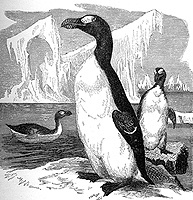
Many species have get extinct through over-hunting, such as the Passenger Pigeon, and many others have become endangered or extinct through habitat destruction, deforestation and intensive agriculture.
The passenger pigeon was possibly the nearly common bird in the earth, with an estimated v billion in the U.s.. They lived in massive flocks, with 1 flock estimated at ii billion birds and taking several days to pass overhead. But passenger pigeons also were very pop for nutrient and hog feed, and were shot in mass numbers by commercial hunters. By 1900, the final wild passenger dove was killed.
Too, the Great Auk, flightless rails, and the moa of New Zealand, for case, all became extinct due to homo influence. The flightless dodo became extinct in the 17th century, largely because of animals brought by people that damaged the dodo's nests, too every bit habitat destruction.
Many parrots are endangered because of poaching for the pet trade, and habitat destruction, both past humans and past animals introduced by humans.
Evolution
There are two major conjectures regarding the origin of birds (Mayr 2001). One, the thecodont theory, is that birds arose from archosaurian reptiles erstwhile before the Upper Jurassic (around 135 to 160 meg years ago), perhaps in the late Triassic more than 200 million years ago. The other scenario is that birds evolved from theropod dinosaurs. This subsequently dinosaurian theory, which is quite pop, is supported past the remarkable similarity between birds and bipedal dinosaurs of the later Cretaceous, around lxx to 100 million years agone. (See geologic time scale.)
The oldest known fossil bird Archaeopteryx, from the Upper Jurassic, is considered as ane of the first "missing links" to be institute in support of evolution, later the first fossil specimens were found in the tardily nineteenth century. However, it as well presents a complication for the dinosaurian theory. Archaeopteryx lived some 145 million years ago. Eminent evolutionist Ernst Mayr (2001) notes that this species has then many advanced avian characters that the original birds much accept existed considerably earlier. Withal, at that place take not been any birdlike dinosaurs known from the Jurassic or earlier periods. The virtually birdlike dinosaurs occurred in the Cretaceous period, well later Archeopteryx disappeared. There are other complications that Mayr lists, including that the digits in the hands of dinosaurs are two, three and 4, while they are one, ii, and three in birds, and that it is inconceivable how the extremities of birdlike dinosaurs could have been shifted to flight, being reduced and not pre-adjusted to become wings.
The recently discovered dromaeosaur, Cryptovolans, appears capable of powered flight, contained a keel and had ribs with uncinate processes. In fact, some consider that Cryptovolans makes a meliorate "bird" than Archaeopteryx, which is missing some of these mod bird features. Considering of this, some paleontologists have suggested that dromaeosaurs are actually basal birds whose larger members are secondarily flightless, i.east. dromaeosaurs evolved from birds and not the other way around. Prove for this theory is currently inconclusive, but digs continue to unearth fossils (especially in Communist china) of the strange-feathered dromaeosaurs.
Information technology should be noted that although ornithischian (bird-hipped) dinosaurs share the same hip structure as birds, birds are actually considered by many paleontologists to have originated from the saurischian (cadger-hipped) dinosaurs, and thus arrived at their hip structure condition independently. In fact, the bird-like hip structure also is speculated to take developed a third fourth dimension amongst a peculiar group of theropods, the Therizinosauridae.
References
ISBN links support NWE through referral fees
- Gowaty, P. A. 1983. Male parental intendance and credible monogamy amidst Eastern Bluebirds (Sialia sialis). The American Naturalist 121(ii):149-160.
- Ketterson, Eastward. D., and 5. Nolan. 1994. Male person parental beliefs in birds. Almanac Review of Ecology and Systematics 25:601-28.
- Mayr, E. 2001. What Evolution Is. New York, NY: Basic Books.
- Zeveloff, Due south., and M. Boyce. 1980. Parental investment and mating systems in mammals. Development 34(5):973-982.
Credits
New Globe Encyclopedia writers and editors rewrote and completed the Wikipedia commodity in accordance with New World Encyclopedia standards. This article abides past terms of the Creative Commons CC-by-sa three.0 License (CC-by-sa), which may be used and disseminated with proper attribution. Credit is due under the terms of this license that tin can reference both the New World Encyclopedia contributors and the selfless volunteer contributors of the Wikimedia Foundation. To cite this article click here for a listing of acceptable citing formats.The history of earlier contributions by wikipedians is accessible to researchers here:
- Bird history
- Feather history
- Bird_skeleton history
The history of this article since information technology was imported to New World Encyclopedia:
- History of "Bird"
Note: Some restrictions may utilize to use of individual images which are separately licensed.
Source: https://www.newworldencyclopedia.org/entry/bird
Posted by: byrdboashe.blogspot.com

0 Response to "What Animal Classification Is A Bird In"
Post a Comment